You can hardly talk about the Reserved List for two minutes until someone mentions Black Lotus, often in hysterics. It’s the Magical equivalent of ‘Godwin’s law,’ that ‘as an online discussion grows longer, the probability of a comparison involving Nazis or Hitler approaches 1.’ If Godwin’s law is reductio ad Hitlerum, Menendian’s law is reductio ad Black Lotum.
The frequent invocation of Black Lotus and Power Nine demonstrates how difficult rational discussion on the issue of the Reserved List can be. There are 572 cards in the reserved list. Black Lotus and the power nine constitute 1.57% of the Reserved List, yet they often overshadow and distort the discussion.
Not even Wizards can resist. In Wizards’ recent blog posting here about the presence of Phyrexian Negator (a reserved card) in an upcoming Duel deck, they assured folks that although Masticore would be appearing in From the Vault: Relics, BLACK LOTUS, posted as a super-sized image just above another image of the five Moxen, would not.
The Reserved List was created in the wake of Chronicles, a reprint set that enraged collectors by devaluing many of the cards from Legends, Antiquities and Arabian Nights.
The purpose of the Reserved List is to preserve the value and collectability of cards by promising investors, players and collectors that some cards won’t lose value or collectability because of reprints.
Guess what the median value of a card on the Reserved list is.
Does the reserved list actually serve the purpose of preserving card value and/or collecbility? Consider the answer to the poll.
Wait for it…
Wait for it…
Wait for it…
99 cents.
Yep. That’s right. Here is a spreadsheet to all 572 cards on the Reserved List. The median value of a card on the reserved list is price of a Whopper on the dollar menu. The majority of the cards on the list are worth pennies. And all of those cards are rares! Only 21 cards (4%) of the Reserved List is even worth more than $50.
The Reserved List neither preserves value nor collectability, at least, not to the extent that its defenders imagine.
Consider Underground Sea.
Here are current SCG prices for each printing of Underground Sea:
Underground Sea (Alpha) — 599.99
Underground Sea (Beta) — 599.99
Underground Sea (Unlimited) — 99.99
Underground Sea (Revised) — 69.99
Pause to think about it; this is quite remarkable. A heavily played Revised Underground Sea, priced at 59.99, is worth ten times less than a functionally equivalent Alpha or Beta version of the exact same card. The value and collectability of Alpha and Beta Underground Seas do not appear to be affected one iota by the fact that there are Revised printings.
In fact, and perhaps the most astonishing bit of research I uncovered, according to the Black Lotus Project, which tracks card prices, Underground Sea is now worth more than 2/3s of the power nine! Underground Sea is the fourth most valuable card in Beta! SCG pricing also reflects this. Beta Underground Sea has the same price as most of the Beta Moxen.
But here’s the rub: It’s known that there were 1100 of each Alpha rare printed, 3200 of each Beta rare, and 18,500 of each Unlimited rare. In short, there were only 22,800 copies of Time Walk, Mox Pearl and Black Lotus ever printed. In contrast, there were 302,200 copies of each Revised rare printed. That’s a more than 13 fold difference in the number of cards printed between Revised and A/B/U.
And yet, despite that 13 fold difference, Alpha and Beta Underground Seas are as valuable, if not more so, than most of the power nine.
Conclusion? You could print a million new Underground Seas in M11, and Alpha and Beta Underground Seas would probably not budge in their value or collectability. In fact, they might become more valuable!
Consider Shivan Dragon, Wrath of God, and Birds of Paradise:
Shivan Dragon (Alpha) — $199.99
Shivan Dragon (Beta) — $199.99
Shivan Dragon (Unlimited) — $14.99
Shivan Dragon (Revised) – $2.99
Shivan Dragon (Xth Edition) — $1.99
Shivan Dragon (From the Vault) — $1.99
Shivan Dragon (M10) — $0.59
A gajillion reprints have not affected the price or collectability of Alpha and Beta Shivan Dragon one bit. And it’s not because of the fact that Alpha and Beta have black borders. So do M10 and FTV. Non A/B Shivan Dragon is cheap because the card isn’t playable in any format. Its value is almost entirely based on casual play and its iconic status. That’s in contrast to these cards:
Birds of Paradise (A) – $200
Birds of Paradise (B) – $200
Birds of Paradise (U) – $25
Birds of Paradise (RV) – $12.50
Birds of Paradise (4th) – $9
Birds of Paradise (5th) – $10
Birds of Paradise (6th) – $10
Birds of Paradise (7th) – $10
Birds of Paradise (8th) – $10
Birds of Paradise (RAV) – $10
Birds of Paradise (10th) – $10
Birds of Paradise (M10) – $6
Wrath of God (A) – $150
Wrath of God (B) – $150
Wrath of God (U) – $20
Wrath of God (RV) – $15
Wrath of God (4th) – $12.50
Wrath of God (5th) – $12.50
Wrath of God (PT) – $20
Wrath of God (6th) – $12.50
Wrath of God (7th) – $12.50
Wrath of God (8th) – $12.50
Wrath of God (9th) – $12.50
Wrath of God (10th) – $15
I could go on, but the point has been quite vividly illustrated. Numerous reprints simply do not affect the value of Alpha and Beta printings much one way or the other. If it is an Alpha or a Beta card that people want, either because it is a card that is played in current formats (like Wrath of God or Underground Sea) or a sought-after collectible because of its iconic status (a la Shivan Dragon or Juzam Djinn), the card will have plenty of value. Does anyone think that a reprint of Juzam Djinn would affect its Arabian Night price?
It’s quite clear that ‘collectability’ and value remain for certain card printing regardless of the number of times they’ve been reprinted. In short, the Reserved List does not protect the value or collectability of, say, Beta Underground Sea whatsoever. The Reserved List does not fulfill the purpose for which it was designed.
We know, without a doubt, that card values are, more than supply, a function of usefulness in relevant formats. The better a card is, the more valuable it will be as a function of demand.
I can remember the first ‘chase card’ I ever purchased: Argivian Archaeologist, which was a $25 in (probably early) 1995 when I purchased one. I don’t even remember what it was that I thought I’d be recurring, (perhaps Mirror Universe?), except that that card was hot. That card is now worth less than $9, and virtually all of that value is collectability and casual use.
Illusionary Mask, once a multi-archetype strategic engine card in Vintage, was worth about the same price as Bazaar of Baghdad and Mishra’s Workshop. However, while Workshop and Bazaar both climbed to $200 and beyond, Illusionary mask lost more than half its value after peaking above $100. The reason is simple: Mask, Bazaar and Workshop were each about as good as each other, and each archetype and format defining cards. Today, Mask sees zero play, while Workshop and Bazaar continue to be great.
Consequently, today Illusionary mask is worth $60, at best. Before it began its climb in 2002-2003, Mask was worth about $25-$30. Mask is about as useless as it was before it became really good in Vintage, and after rising to $120 or so, it has fallen back to $60. In short, in about a decade it has only gained $30. At least some of that price increase can be attributed to residual demand, and stickiness in the price. People who probably invested in Masks aren’t interested in selling them at the prices that they are currently going for, so the supply has decreased, so that the equilibrium value is around $60 rather than $30 in 2002 dollars.
Looking at Legends we can begin to quantify the part of a card’s value that comes from utility or usefulness and the value that comes from collectability or scarcity. Cards that were once valued in the $30 range have in the mid-1990s fallen to a stable level around $15ish,like Thunder Spirit, which is probably where many of the rares like Killer Bees would be had it not been reprinted in 4th Edition and Chronicles.
In reflecting on the Reserved List, and whether it serves the purpose for which it was designed, consider this question: but the question is: where would the prices of Elder Dragons and Carrion Ants be today, if Chronicles would never have been printed?
It’s clear to me that Chronicles is no longer impacting the price of the “money” cards from Legends: demand is the key. Just like Beta, Legends cards retain value because they were from Legends. Edition matters. What the drafters of the Reserved List didn’t and frankly couldn’t understand, but what we can appreciate 15 years later, is that Edition matters. Collectability is as much a function of printing edition as it is functionality.
As Ben Bleiweiss recently revealed, Wizards asked me, Ben and Eric Reasoner to visit to discuss the Reserved List. My participation was primarily to provide insight into perspectives of the Eternal Community.
On the big morning, Ben and I stumbled out of our hotel room, ate breakfast, then wandered out of the hotel in search of Wizards HQ on foot. It was supposed to be within short walking distance. It felt like a crisp Spring morning. Except that it was January. in Seattle.
Wizards’ offices are nested in a commercial park. There is a circle of hotels and office buildings. We came upon this building, which we both were certain was Wizards HQ:

“This is a close up?”
I guess Ben forgot the zoom.
Ben managed to snap this photo after a few attempts, but it turns out that this wasn’t Wizards office building after all. Wizards was in another, identical building a block away.
We walked into the lobby, and took the elevator to the fourth floor, Wizards home. When you get off the elevator and turn into the Wizards entrance, this is what you see:
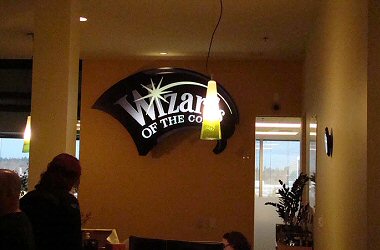
This is the fourth floor entrance to Wizards of the Coast! The receptionist is seated behind the computer in the middle of the photo. People pass through here greeting each other on the day.
Catercorner to the receptionist desk is this guy!

Here’s another look at the guardian Red Dragon hovering in the lobby:

Just to the left of the receptionist desk is the lobby. Here’s what you find:

In the corner, by the window, is a weary Soldier, trotting with his sword hoisted above his shoulder. On the far left is a library of foreign-language WOTC publications and games:

I perused the library, examining the many publications and novels, and gaming awards kept here.
On the other side of the room, in the corner, is this:
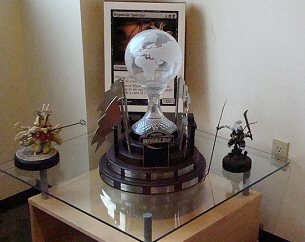
It’s the Magic World championship Plaque, inscribed with those hallowed names.
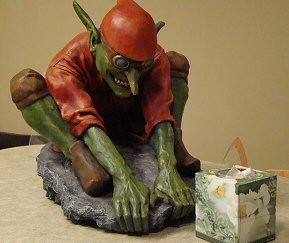
This guy, the Goblin Rock Sledder, can be found all over Wizards. He’s a popular dude.
Once Mike Turian and Aaron Forysthe pulled Ben and I from lobby, we were given the tour. Wizards entrance is on the fourth floor, but most of the work is done on the third floor. Wizards office workspace is actually an enormous circle, not unlike, spatially, the interior of an giant tree. All of the offices and work areas set off from the main, circular corridor, and are very open. I saw the D&D area, and the famous magic “Pit.” Nested around the pit were the desks of Tom LaPille, Erik Lauer, Mark Globus, Mike Turian, Ken Nagle, and more!
As we walked through my jaw dropped at paintings of REDACTED and CENSORED, which I imagined were commissioned for Magic 2011. I also happened upon a foil sheet of Worldwake, just laying upon a cabinet surface! Keep in mind that this was in mid-January, when only a fraction of the set had been spoiled! Aaron quickly ushered me forward…
But then I came upon this mouth watering sight:
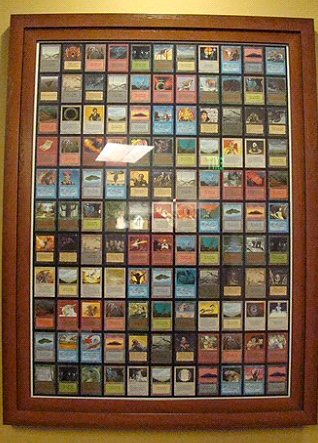
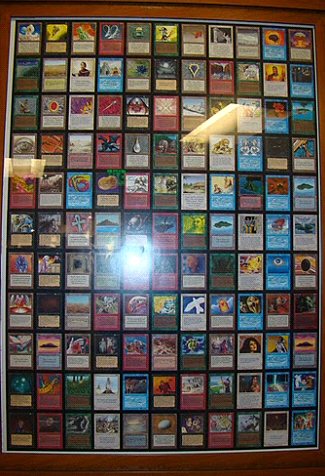
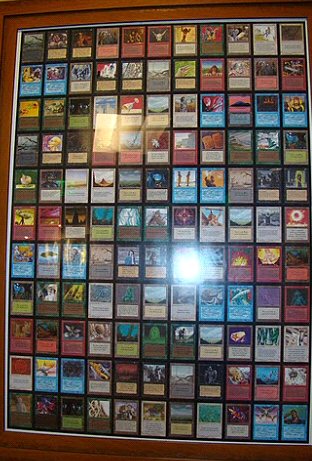
Hanging like a DaVinci was a framed Beta Sheet. The first was the common sheet. The second was the rare sheet. And the third was the uncommon sheet. See if you can identify the cards on the sheet.
Check it out:
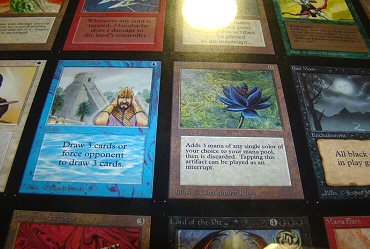
Imagine opening a Sealed Deck with Black Lotus and Ancestral Recall! They are right next to each other on the sheet. Although, I imagine that most folks would have been more excited about the card below Black Lotus: Lord of the Pit!
I couldn’t resist taking this photo:
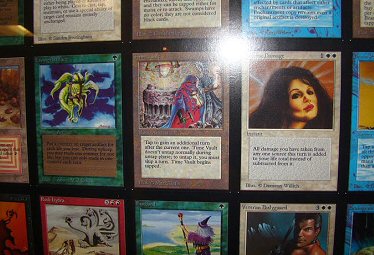
Then, Ben and I split up. Ben set off into meetings to discuss various Wizards products. Tom LaPille, Erik Lauer and myself retired to the Mishra’s Workshop, to discuss Eternal formats:

Then, we all met in one of the larger spaces to 8-man booster draft Zendikar, Zendikar, and Worldwake. I made no effort to conceal my glee upon reading cards like Bojuka Bog and Thada Adel. I could hardly believe my eyes! I drafted an unreal virtually mono-White deck that defeated Mark Globus’ mono red deck. I had to wait several weeks to be able to discuss some of these cards!
After lunch, as Ben reported, we began our larger meeting concerning the Reserved list.
The bottom line is twofold. The good news for Legacy players is that Wizards loves Legacy. They recognize its natural popularity and they want to support it. They don’t want to alienate the Eternal player base.
At the same time, they also want to reprint cards like Silver Queen. The consensus in the room was that the Silvers Premium Deck Series would have been a much superior product if they had included Sliver Queen, which they did not on account of the Reserved List. Then, they shared with us the fact that they were reprinting Phyrexian Negator in the Phrexia v. the Coalition duel deck. While the reserved list stipulates that they may reprint cards as ‘premium’ versions (i.e. foils) (and they have, such as Intuition and Yawgmoth’s Will, both of which are judges foils), they were concerned about potential reaction among the community.
Here’s what I tried to explain:
First, the Reserved List does no longer accomplishes the purposes for which it was designed (if it ever did), and actually undermines some of those purposes. I spent the first part of this article making this point. Just compare the prices of the various printings Underground Sea and Wrath of God.
Second, the long run health of the game is coincident with the long-run health of the company, and the long-run health of the game is best served by reprints. If the Reserved List just failed to serve its purposes, it would be a harmless relic. But it doesn’t just fail to serve its purposes; it actually harms.
The reserved list is a fundamental impediment to the growth of Eternal formats, and Legacy most pressingly. Legacy’s growth, on its current course, is simply unsustainable without reprints.
A mere two and half years after it was printed, Tarmogoyf is as valuable as Mox Pearl was two and half years after it was printed. That’s a remarkable fact. Especially when you consider that Tarmogoyf is in roughly 45% of all decks in any given Legacy tournament. Tarmogoyf isn’t the problem, though. Wizards could reprint Goyf at any time. After all, it was timeshifted from the future.
The fundamental problem for Legacy is dual lands.
Dual lands are to Legacy what Power 9 is to Vintage. You can enjoy the format without them, but to compete in the long-run, you will need them. Yet dual lands are quickly becoming unaffordable.
Dual lands, which were about $20-40 per land for years, have doubled in price in the last few months. By the end of 2010, it is not inconceivable that dual lands could each be approaching $100.
Grand Prix: Chicago, the last American Legacy Grand Prix, was the largest Grand Prix on American soil at the time. And, as I write, Grand Prix Madrid has just weighed in at 2,220, the largest Constructed tournament in Magic history! How can you expect to reach those numbers if dual lands are $100 a piece? Requiring players to spend a hundred dollars on a piece of cardboard or two is simply untenable for a broad based format.
Simply put: if you want to compete in Legacy in the long-term, you will need dual lands.
And: The only reason Vintage can survive as a playable tournament format is because of proxies. Proxies allow people to enjoy Vintage without having to spend $4000 on a manabase.
But if Wizards wants to support Legacy as a broad-based Grand Prix or PTQ format, and all indications are that they do, then the price of entry is on a collision course. Legacy could actually become more expensive than Vintage-with-Proxies. The obvious solution? Reprints to drive the price down, and increase the price-availability of these cards. For Tarmogoyf that’s easy to do. Unfortunately, dual lands are on the reserved list, of cards that cannot be reprinted, either as they were or as functional equivalents.
As Ben said a few weeks ago, what’s happening in Legacy is what happened to Vintage. Wizards appears to have decided that it will overcome the Silver Queen issue by allowing itself to print cards on the reserved list per the caveat that it can print premium versions of those cards. While that is one way to deal with cards like Sliver Queen or Masticore, that is not a solution to Legacy.
Legacy’s popularity and concomitant price spikes will engender its own marginalization unless the reserved list is abolished. And time is of the essence. As prices rise, more and more players will oppose such a move as more and more value is stored in these cards.
As I said at the beginning of this article: we are now at the point where Tarmogoyf is worth more than Black Lotus two and half years from its printing. As dual lands increase in price, the opposition to addressing the reserved list will only become more intense among certain player segments.
It is important to understand that the Eternal community is not a monolithic bloc. There are many different degrees of investment within the Eternal community. Different segments of the community would feel differently about reprints on the reserved list or more generally:
1) The Player That Owns Everything
Among Legacy players, there are the very few, perhaps as few as 2% of people who will show up at a Grand Prix, who can basically build any deck in Legacy. They own everything from The Tabernacle of Pendrell Vale to Moat to Imperial Recruiter. They can build ANT or they can build Aggro Loam. These players not only have all 40 dual lands, but they own playsets of almost every staple in the format from the roguest of rogue decks to the main format archetypes. Most own more than 40 dual lands. Many own 60+ dual lands. The elite subset of this player, aka the Foil King, owns 80+ dual lands, which they horde or use as trade bait. These players also own lots of Force of Wills. Many of these players try to foil out their cards, and has foil fetchlands and black bordered dual lands.
2) Own All of the Staples
These are the Legacy players who own all or most of the 40 dual lands, all of the fetchlands, and the vast majority of the core staples. They can build almost anything you would want to build on short notice, with the exception of a few high priced cards, like Loyal Retainer, Moat or Imperial Recruiter. Again, there aren’t many of these players, perhaps as few as 2-3% of regular Legacy players. These players, for the most part, can build many of the rogue decks in the format too, like High Tide or Dream Halls combo. They have an extensive collection that is deep and wide.
3) Own Most of the Staples
This player that owns 25+ dual lands, most of the major cross-format staples in the format. They can build into most of the popular decks in the format, but generally don’t have the cards on hand to build any rogue deck, or to build it optimally. With some trading, they can acquire what they need.
4) Owns Many of the Staples
This is the player that owns 10-15+ dual lands, mostly in the colors they prefer or they feel are most important. They own what they feel are the most important staples, and they can build a number of Legacy decks, and own most of the cards they enjoy playing. With a few months time, they could purchase or otherwise acquire whatever they need to build almost any deck. This is probably the average invested Legacy player on the Source. They face real limits in what they can build on a short-time frame, but they have a large enough collection that they have more than one option. I probably fall into this category.
5) Owns A Few Specific Decks
This person is limited to maybe 2-3 archetypes, with some key variation. They own around 10 dual lands or less, and they often borrow a few duals to build they decks they want to play, or they play mono-colored decks. This player is often a newer Legacy player, and often a newer Magic player. They are still acquiring cards they need. They’ve played more than one deck in the last year, which is why they are able to build several archetypes.
6) Owns a Major deck and Sometimes Part of Another
This is a player that has invested in Legacy, but is only able to play one major deck, like Goblins, Merfolk, or the Rock. They may have some cards on hand to build part of another, like Dredge. To acquire anther deck, they have to sell or trade what they have invested in now. A lot of legacy players fall into this category.
7) The Non-Legacy Player
This player is interested in playing at one of the SCG Opens or a Legacy Grand Prix. And if they aren’t connected into a Pro network or a generous local dealer or friend, who can let them borrow the basics they need, they will often come into the format playing one of the cheaper options available, like Dredge, Burn, or Goblins/Elves. Or, they will port their Extended or Standard deck into Legacy, with whatever upgrades they can make. This player is, I would guess, 20% or more of the SCG Opens or Grand Prix field.
Now, consider where you fall. If Wizards were to abolish the reserved list, which players are most affected? Obviously, the (1), (2), and (3) player are the most affected, and the (1) type is obviously the most likely to be opposed to reprints out of a totally understandable concern for the value of their investment/collection.
But, consider the other side of the Ledger. This player obviously adores Legacy. They enjoy playing Legacy and the opportunity to play in more high-profile tournaments, where they are likely to excel. This player has the most to gain, in principle, from increased Legacy popularity. The value and utility of their entire collection rises. But more importantly, they will have more opportunities to enjoy the format they love.
But even those folks that have the most to lose in the Legacy community pale in comparison to the investment that a fully invested Vintage player has made. Not only does the Vintage player need to own many of the same dual lands, they have to own an array of cards priced at Tabernacle’s value, and higher. The Vintage player segments are less defined by the quantity of dual lands they own (Vintage players don’t own as many dual lands as Legacy players), but rather than the amount of power, and sub-power cards like Mana Drains, Mishra’s Workshops and Bazaar of Baghdad. The Vintage players would actually benefit the most by reprinting dual lands, because they have they have a lesser investment. I would wager that very few Vintage players actually own every dual land. I’ve never owned 40 duals, but I’ve owned 4 Mox Sapphires.
But without a doubt, the most mystifying thing to me is the concern that Wizards might reprint power among people who don’t own power! If you don’t own power, what possible objection could you have to its printing? Obviously, if power were reprinted, it would not be done in a way that would affect Standard. But if it were reprinted, what harm would there be? I believe that the fear that Wizards might reprint power is used by people who don’t own power to defend the Reserved List far more than you might think.
I own power, and I would be thrilled if they reprinted power. Alpha and Beta power would, much like Beta Berserk or Beta Birds of Paradise, maintain its value. In fact, the increased popularity of Vintage afforded by an increased supply of power might actually make A/B power more valuable in the long run.
Collectors, people whose primary interest in the game is collecting rather than playing, are a very tiny proportion of magic players. Some of them are elite collectors, folks that chase down summer Magic rares and other oddities. Some are just folks who want 4 of every card printed. Reprints affect these folks differently depending on how they view the game. For investor-collectors, reprints that devalue their collection would be greatly alarmed. It’s an open question how reprints on dual lands would affect the price of Revised dual lands. However, for collector-collectors, reprints that have a different face, art, and frame would not diminish the ‘collectability’ of the original card. Just look at the popularity of Alpha and Beta cards like Birds of Paradise or Wrath of God. Numerous reprints have done little to reduce the value of these cards. In fact, they’ve possibly contributed to a rise in their price.
Wizards should abolish the reserved list. It no longer accomplishes the purposes for which it was created, and actually undermines some of those purposes. More practically, the reserved list is a fundamental impediment to the growth of Eternal formats, and Legacy most pressingly. Legacy’s growth, on its current course, is simply unsustainable without reprints.
If Wizards did abolish the Reserved List, as I advocate, it would be a mistake to announce a de facto reserved list or merely shorten it. There should be no special exception for power. It astonishes that so many people who support reprinting cards on the reserved list are opposed to the reprinting of power. One view is that power is too broken to reprint. A review of the actual Vintage format shows that Vintage can be a very healthy format because although some cards are broken, the answers are just as efficient as the threats. Another view is that having unlimited Black Lotus cost $800 is good for Magic, in that it’s an ultra-mythic card. I can’ t believe that anything that could be good for Vintage, such as reprints, wouldn’t also be good for Magic. The interests of Magic and Vintage Magic are too deeply intertwined. Finally, too many people “feel” that power shouldn’t be reprinted. Feelings are not reasons.
The desire to reprint cards on the reserved list is not a sign that Magic is dying, but rather a sign that it is growing far beyond what its creators could have imagined.
Until next time…

